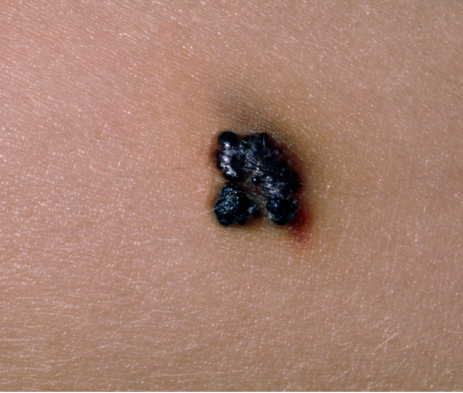Angiokeratoma Treatment London
There are many different types of angiokeratoma. Probably the most common types that present to the clinic are solitary angiokeratoma and angiokeratoma of fordyce.
The team at The Dermatology Clinic London offer a number of treatments for all types of angiokeratoma, including angiokeratoma of fordyce. Get in touch today to find out how we can help.

What is angiokeratoma?
An angiokeratoma is a benign lesion which is formed of a small group of dilated blood vessels in the superficial layer of the dermis (skin). Angiokeratoma present as small red, blue or purple marks on the skin, usually no larger than 5mm in diameter. Angiokeratoma can occur anywhere on the skin. They are normally harmless but occasionally can bleed or become painful. They can have a rough or a smooth surface.
There are many different types of angiokeratoma. Probably the most common types that present to the clinic are solitary angiokeratoma and angiokeratoma of fordyce.
What causes angiokeratoma?
The causes of angiokeratoma vary. In most cases it’s unclear exactly what the cause is. Some people think angiokeratoma of fordyce are related to increased pressure in the veins close to the skin’s surface and are more commonly associated with blood vessel disorders, such as varicoceles and haemorrhoids.
Rarely (1 in 40,000-60,000) angiokeratoma result from Fabry’s Disease, a genetic condition which can result in clusters of angiokeratoma, these most commonly occur in late teens. There are several other rare types of angiokeratoma that can present at birth or in childhood.
Solitary angiokeratoma treatment London
Occasionally lesions need to be removed surgically for histological confirmation of the diagnosis. This is normally done under local anaesthetic and requires sutures. Generally, this type of angiokeratomas are solitary although multiple lesions can occur on the lower legs.
Angiokeratoma of fordyce
Angiokeratoma on the scrotum or angiokeratoma on the vulva are known as angiokeratoma of fordyce (named after the dermatologist John Addison Fordyce). These are not to be confused with fordyce spots which are white spots found on the lips and the penis.
Angiokeratoma of fordyce are characterised by small red, blue or purple papules on the scrotum, penis or vulva. They can start with one or two angiokeratoma but can progress to become many in number. The risk of developing angiokeratoma of Fordyce increases with age. Usually, the papules appear in clusters around the scrotum, penis and vulva.
Angiokeratoma of fordyce treatment in London
No treatment is needed if the angiokeratomas of fordyce are causing no symptoms. However, if there are concerns about the cosmetic appearance of the angiokeratoma or if the lesions have become painful or bleed; then they can be treated.
Angiokeratoma of fordyce – before and after treatment


Hyfrecation (electrocautery) can be very effective as can curettage and cautery, cryotherapy and laser. We generally use a local anaesthetic cream applied for about an hour prior to treatment. Any intervention can result in a mark and any treatment may require more than one session to clear the lesions. It is important to understand that having cleared the angiokeratoma, they can over time recur. If the diagnosis is uncertain, the angiokeratoma should be surgically excised, (cut out under local anaesthetic) and sent for analysis.
Angiokeratoma Frequently Asked Questions
In general, angiokeratomas of fordyce do not need treatment unless you are experiencing pain, discomfort or bleeding. They can also be treated to improve the cosmetic appearance. If you want your angiokeratoma to be treated then this is best done in a Dermatology clinic rather than at home.
Angiokeratoma of Fordyce appear in the genital areas, so some people may be concerned that they are a symptom of a sexually transmitted disease (STD). This is not the case, angiokeratoma are not contagious.
Unfortunately unless treated, angiokeratomas tend to persist and increase in number and size over time.
Angiokeratomas are a non-cancerous skin condition. However, very occasionally if they are particularly dark in colour they can be confused with skin cancer. If there is any concern about the possibility of skin cancer; the lesion in question should be reviewed by a Dermatologist.
Unfortunately creams tend not to be effective in treating angiokeratoma. Treatment will be by surgical methods, cautery or occasionally laser.
They are generally asymptomatic, mainly when they first form. However, they can become itchy and uncomfortable. If you do experience any symptoms, discuss this with your Dermatologist.
Angiokeratoma of fordyce tend not to occur in the vagina but do occur on the vulva which consists of the external female sex organs. They present as small raised spots varying in colour from red through to purple or even almost black to the naked eye. They are normally asymptomatic, but can bleed or be uncomfortable. If so they can be treated by your Dermatologist.




